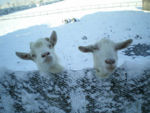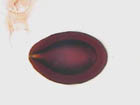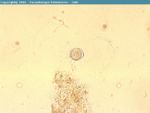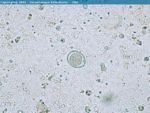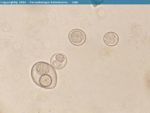Introduction
- The oocyst is the resistant stage in the environment
- The infective sporozoite is released from the oocyst
- Inside the host, the sporozoites invade the intestinal epithelial tissue
- Sporozoites feed and grow
- As the sporozoite grows the nucleus divides forming a schizont
- The schizont contains numerous elongated merozoites
- The formation of merozoites is the first asexual reproductive stage called schizogony
- The schizont ruptures releasing the merozoites which also invade the epithelial cells
- Another generation of schizonts form which is the beginning of the sexual phase of reproduction called gametogony
- The merozoites form male microgamonts or female macrogamonts
- Collectively known as gamonts or gametocytes
- The microgamonts released from the microgametocyte penetrate and fertilise the macrogamont (which is contained within the macrogametocyte)
- Gametogony forms the zygote
- Surrounded by a cyst wall
- Forms the oocyst
- The oocyst is passed in the faeces and is unsporulated
- The oocyst becomes sporulated in the second asexual reproductive phase called sporogony
- Once the oocyst is sporulated it is infective
Coccidia of Goats
- Many Eimeria species
- 2 Eimeria are pathogenic
- Cause diarrhoea and a decreased growth rate
- Different species of Eimeria occurs in sheep and goats
Coccidia of Horses
- Only one atypical Eimeria
- Forms large subepithelial gametocytes in villi
- Large, dark coloured oocysts
- Approximately 12μm
- Occasionally causes diarrhoea
- Besnoitia bennetti in larynx of horses
Coccidia of Pigs
- Many species of Eimeria and Isospora
- Only Isospora suis is of clinical pathogenic importance
- Causes sporadic, serious and sometimes fatal disease in unweaned piglets
- Causes profuse diarrhoea
- Very short 1 week prepatent period
- Diarrhoea starts before oocysts are shed in faeces
- Ante-mortem diagnosis is difficult
- Death usually occurs after parasites have left the host
- Post-mortem diagnosis difficult
- Isospora infections are self-limiting
Coccidia of Dogs
- 2 common and 2 less common Isospora species
- Occasionally can cause disease
- Little pathogenicity
- Even if faecal oocyst count is high, other causes of diarrhoea should be looked for
- Hepatozoon americanum and subclinical H. canis in periosteal bone formation
- Both are Tick borne diseases
- H. canis – Rhipicephalus sanguineus
- Ticks become infected by ingesting a blood meal containing macrophages and neutrophils infected with the parasite gamonts -> sexual replication in the gut of the tick -> oocysts containing infective sporozoites -> dogs ingest the tick schizogony occurs in numerous tissues
- Both are Tick borne diseases
Coccidia of Cats
- 2 common Isospora species with little clinical significance
- Oocysts in faeces have to be distinguised from those of Toxoplasma (smaller) and Sarcocytis (sporulated or naked sporocyts in faeces)
Coccidia of Rabbits
- 3 pathogenic Eimeria species
- 2 in the caecum
- 1 in the bile duct
- Eimeria steidae
- Serious disease of both pet and farmed rabbits
- Treatment is by administration of drugs in drinking water
- E.g. Toltrazuril
- Hygiene is the best method of prevention to prevent sporocysts from sporulating
- Medicated feed can be used in commercial units
- E.g. Rabenidine

